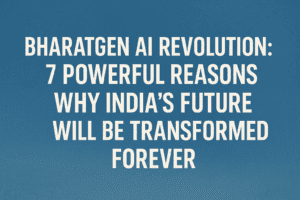BharatGen AI Revolution: 7 Powerful Reasons Why India’s Future Will Be Transformed Forever
BharatGen represents India’s ambitious move to build AI rooted in its own diversity. Far beyond simple translation, this first government-funded multimodal model aims for deep contextual understanding across 22 Indian languages – crucial for truly bridging the digital divide. Its core promise lies in enabling hyperlocal solutions for sectors like healthcare and agriculture, where cultural nuance and local idiom matter. Significantly, it prioritizes ethics grounded in Indian values to counter inherent biases in global AI.
The initiative connects premier academic talent with grassroots innovation through hackathons and a network of tech hubs, focusing on real-world impact like trusted telemedicine in native languages. Success hinges on overcoming challenges like diverse data collection and rural accessibility. Ultimately, BharatGen shifts the paradigm from adopting foreign AI to adapting technology to India’s unique linguistic and socio-economic fabric, empowering communities on their own terms.

BharatGen AI Revolution: 7 Powerful Reasons Why India’s Future Will Be Transformed Forever
The launch of BharatGen, India’s first government-funded multimodal AI model, is more than just a technological announcement – it’s a potential turning point in how a nation of staggering linguistic and cultural diversity engages with artificial intelligence. While headlines focus on the launch, the deeper story lies in its foundational purpose: building AI for India, by India, in India’s languages.
Moving Beyond the “Multilingual” Label:
Yes, supporting 22 Indian languages is groundbreaking. But BharatGen’s ambition goes deeper than translation. It aims for contextual understanding – grasping the nuances, idioms, and cultural references embedded within these languages. This is crucial because:
- Bridging the Digital Chasm: For millions, the digital world remains inaccessible because mainstream AI doesn’t speak their mother tongue. BharatGen promises interfaces – whether for government services, healthcare information, or educational tools – that feel native, not foreign.
- The “Placebo Effect” of Trust: Dr. Singh’s telemedicine anecdote isn’t just about convenience; it’s about human connection. When a doctor (or an AI interface) communicates in a patient’s native language, it builds inherent trust and comprehension, leading to better outcomes. This psychological layer is often overlooked in purely technical AI discussions.
- Unlocking Hyperlocal Innovation: Generic global AI models struggle with India’s regional complexities. Imagine an AI farmer’s assistant in Punjab understanding local soil terminology and crop cycles specific to the region, or an educational tool in Tamil Nadu explaining concepts using culturally relevant examples. BharatGen’s potential lies in enabling solutions tailored to the granular realities of diverse communities.
Ethics Rooted in Indian Ethos: A Necessary Compass
The explicit emphasis on developing “ethical” and “inclusive” AI “rooted in Indian values and ethos” is significant. It acknowledges a critical gap:
- Cultural Bias Mitigation: Global LLMs often perpetuate Western perspectives and biases. BharatGen, developed within India’s socio-cultural context using Indian datasets (presumably curated responsibly), has the potential to offer a more balanced representation and avoid harmful stereotypes relevant to the Indian populace.
- Inclusion by Design: True inclusion means building AI that serves all segments, including rural populations, non-English speakers, and artisans. Aligning with schemes like PM Vishwakarma Yojana suggests a focus on empowering traditionally underserved communities through accessible technology.
More Than a Model: Building an Ecosystem
BharatGen isn’t just a piece of software; it’s the centerpiece of a deliberate strategy:
- Academic-Government Synergy: Led by IIT Bombay’s TIH Foundation under the NM-ICPS mission, it leverages India’s premier academic talent, ensuring deep technical expertise alongside public interest alignment.
- Grassroots Innovation Catalyst: The Generative AI Hackathon 2025 and the network of 25 TIHs (with 4 evolving into TTRPs) are designed to funnel student and startup innovation towards solving India’s unique challenges using this new platform. This could democratize AI development beyond big tech labs.
- Real-World Integration Focus: Highlighting applications in CPGRAMS (grievance redressal) and the explosion of Agri-tech startups (like J&K’s lavender farming) demonstrates a commitment to deploying AI where it impacts daily life and livelihoods, not just theoretical prowess.
The Road Ahead: Challenges & Promise
The vision is compelling, but success hinges on execution:
- Data Quality & Diversity: Building truly representative and unbiased models for 22 languages requires vast, high-quality, and ethically sourced datasets – a monumental task.
- Accessibility & Infrastructure: Ensuring the AI’s benefits reach remote villages requires robust digital infrastructure and user-friendly interfaces.
- Sustainable Development: Maintaining, updating, and scaling such a complex model requires long-term funding and commitment beyond the initial launch fanfare.
The Genuine Insight:
BharatGen represents a fundamental shift: from AI adoption to AI adaptation. It recognizes that for technology to be truly transformative in a society as complex as India’s, it cannot be a one-size-fits-all import. It must be woven into the linguistic, cultural, and socio-economic fabric of the nation. If successful, BharatGen won’t just process Indian languages; it might finally help India’s diverse voices shape and benefit from the AI revolution on their own terms. This isn’t just about catching up; it’s about charting a uniquely Indian path forward in the age of artificial intelligence.
You must be logged in to post a comment.